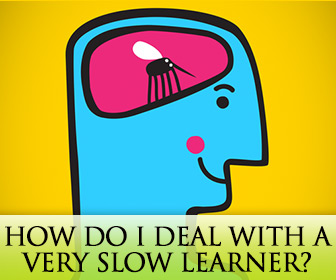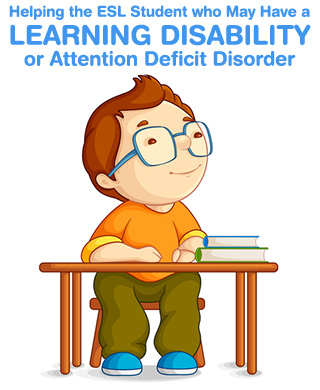ESL Teachers Ask: How Do I Deal with a Very Slow Learner?


They are drawn from a largely poor, migrant farmer population. Although many of them have been here for years, their English acquisition is low, given the circumstances of their lives: they haven’t been able to attend school, and they have little contact with English speakers. Others have fairly strong basic conversational skills in English, having had contact with English speakers for years, but have limited literacy. All are motivated learners who take education seriously, seeing it as connected to upward mobility.
So far, there is probably nothing remarkable in this class description to the ESL teacher—it seems like a typical ESL class. This is correct. However, one of the learners in this class, Juan, is not so typical. He is obviously bright and articulate, has been employed in the farming industry in California for years, and seems to be an acculturated American in many ways - having a car, home, job, and family here. Some of his behavior in class, however, is not so typical. He arrives late on the days he comes and takes perhaps ten to fifteen minutes in locating his seat, the day’s handouts, the schedule, and the sign-in sheet - although these items are always in the same place and have been since he first came to class months ago. He then takes another five minutes or so to locate the correct page in the book and only after consulting his peers in both Spanish and English - and the page is written on the board, as always. And this is on the days when he brings his book, and it is the correct book, which isn’t always the case. When he becomes aware that he is causing a disruption, he is deeply apologetic and obviously embarrassed. While many might think his behavior is deliberate, or the result of lack of concern for his education, or simply the result of not understanding English, I believe it may very well be the result of an undiagnosed learning disability and/or attention disorder due to a number of signs.

There would be an impulse among many educators to think that Juan’s difficulties are simply the result of not understanding English well—he doesn’t know what page we’re on, that is, due to simply not speaking English, not because he’s disabled in some way. This at face value seems reasonable: doctors, for example, have long gone by the dictum, “When you hear hoof beats, think horses, not zebras”—that is, rule out the most obvious and least exotic diagnosis first, as this is also the most likely. However, as in this case, if the student speaks English better than most in the class, and all of the other students understand what we are doing, something besides language seems to be at play.
The assignment is always written in the same place. The handouts are always located in the same place. We always use the same book. Juan’s seat has not changed since the first week of class, nor has the class time. Yet Juan remains confused and is still in the process of adjusting while other students learned the routine the first week of class and have long moved on to focusing on course content. Keeping track of details, routines, and schedules is a major symptom of an attention or learning disability.
Juan is capable of discussions in English on rather complex topics, like the economic difficulties in the U.S. today or inequities in our immigration policies. He’s bright and even articulate. However, he has supreme difficulties in even simple tasks related to literacy like keeping his place in a book as we’re reading aloud or copying something I’ve written on the board in the correct place in his text. While he doesn’t necessarily “reverse letters,” as is the stereotype of “dyslexia,” this difficulty of maintaining his focus on the task enough to complete it in sequential order is suggestive of a processing problem or learning disability.

While I might strongly suspect that a student like Juan has a processing/attention problem, of course I’m not qualified to make a formal diagnosis and wouldn’t feel comfortable doing that. I can, however, without even mentioning anything about ADD or LD, tell Juan he might stop by the student services office of the campus and talk with them. He might actually open up about the problems he’s having and get a diagnosis there, and short of that, at least get some extra tutoring, which also would be of help.
Gently prompting Juan as to what we’re doing when he comes in the door helps: “Class actually begins at 6 pm; the attendance sheet and handouts are up on my desk; we’re on page 48 of your student text…” remind him of what he should be doing. I direct these reminders at the whole class, and usually at least one other student realizes he’s on the wrong page or she hasn’t signed in, so Juan doesn’t feel alone—and he isn’t. Human attention in our connected and fast-paced world is being taxed in a way it in no way has before in our evolutionary history, and most of us have attention problems to a more or less degree.
When students are working independently, I find going by Juan’s desk frequently and just glancing at his work to make sure he’s on the right track helps. In this way, he can check himself before he writes a whole column of words, for example, in the wrong place.
Teaming Juan up with a strong learner in the class has been helpful. In addition to helping Juan individually, creating a supportive learning community where students feel they are working cooperatively, not competitively, is of benefit to the entire class. It’s been observed that techniques that help a student with learning difficulties actually benefit the entire class. Juan is lucky in that he lives in a small, rural Latin community, the kind that is historically collective rather than competitive in nature, and his peers’ impulse is generally to give assistance to him, as they would anyone, when he appears to need help. But even if the learning community is not so supportive already, this community can be built by the instructor through emphasizing community over competition, through setting up group projects, and by recognizing each student as a member of the “team” who contributes to that team through her unique strengths.
Students with these difficulties may in fact be used to being seen this way, and may begin to believe it of themselves. However, in a world that places increasing demands on our focus and attention, there are more and more students who present with difficulties in learning and attention. By recognizing the difficulties the individual student might have in these areas and employing some relatively simple strategies, the teacher can help not only the individual student succeed and manage his learning, but also the entire class.
Do you have students you suspect might have a learning or attention problem? What are some strategies you employ to help them?